-

人教版新目标初中英语八年级上册What are you doing for vacation教案2篇
Teaching goals : 1. Words & phrases: babysit ,get back , fishing , rent , think about , decide(on) , tourist etc. 2. How to talk about future plans . 3. 现在进行时表示将来计划或行动. 4. 特殊疑问句(where , when , how long引导) Important and difficult points : Drills :What are you doing for vacation ? I’m watching TV . When are you going ? I’m going … . How long are you staying ? We’re staying for five days . Teaching aids : cards and a tape ,a large wall calendar . Period 1 Teaching procedures : Step 1Leading in1. Free talk . 2. Put up the wall calendar . T: I’m staying home on Saturday (pointing to next Saturday ).Ss repeat . Ss: I’m staying home on Saturday . T: OK. Today we’ll learn how to talk about future plans. Step 2Pre-task SB Page 13 , 1a . 1. Look at the picture carefully and tell what you see in the picture . 2. Write the activities from the pictures in the box and add some more . 3. Practice reading . Step 3While-task1. Using the activities we write in 1a to make conversations .For example :What are you doing for vacation ? I’m visiting my uncle . 2. Pairwork .Practice in pairs . 3. 用第三人称练习对话.

人教版新目标初中英语八年级下册What should I do教案2篇
说明:在帮Li Lei提建议的同时,教育学生如何学好英语。第三课时教学目标1. 语言目标:a) 词汇: Original, in style, haircut, the same as.b) 语言结构:My friend wears the same clothes and has the same haircut as I do.2. 能力目标:大多数学生能够谈论自己喜欢哪种服装,提高查找信息的能力。3. 情感目标:学会如何与朋友相处,要有自己对时尚的看法。教学重点掌握一些重要词汇。教学难点学会谈论问题,并能提出书面建议。◆教学突破首先针对Erin的问题,提出个人的建议,模仿2c部分的对话展开双人交际Pair-work;听老师诵读3a部分的信件,并找出LEFT OUT的问题所在;学生完成3b部分的内容,给Left Out提出书面的建议;学以口头形式提出自己目前存在的某个问题,讲给大家听,让同学们给自己提出一个建议,并作笔录;学生两、三个人分成一组,随意性地进行口语交际,谈论P14的第4部分的某个问题,相互交换意见。

人教版新目标初中英语八年级上册What’s the matter教案2篇
She shouldn’t go to the party tonight.Step7. TaskT: You know, there are lots of problems in our life. If you are a doctor, please tell us how to solve the problem. I will divide you into 9 groups. Please work in groups. And then choose one of you to report your ideas.The following are the problems:I have a toothache.I am hungry. I have a sore throat.I am stressed out. I have a sore back.I am tired. I can’t sleep.I have a cold. I have a headache.Report: If you have a headache, you should go to bed early. You should see the doctor. You should eat some medicine. You shouldn’t wash your face with cold water.You shouldn’t sleep late.You shouldn’t swim.…..T encourages the students to give advice as much as possible.Homework:1. Chose one of the problems, and write down your advice2. Copy the new words这一步是用于热身的,同时也可以让他们复习一部分的表示人体部位的单词,扩充知识.学习语言的过程也是一个不断积累的过程,复习旧知识,增添新知识.通过小游戏,强化学生对Does she/he have…这个句子的运用能力.通过复习,自然的引到下面新知识的学习。充分利用表格,由句子到对话,再到文章,让学生循序渐进. 提高学生的综合语言运用能力,运用以前学过的知识来解决身边的问题.Period 5 (Section B 3a—3c, selfcheck)教学内容与分析:

人教版新目标初中英语八年级下册If you go to the party, you’ll have a great time教案2篇
区分宾语从句、定于从句和状语从句宾语从句和状语从句,都叫做主从复合句。宾语从句主要是中考必考的,是初中阶段必掌握的从句,宾语从句主要是掌握三要素,所谓宾语从句,就是宾语在主从复合句当中充当宾语的一个句子,叫做宾语从句。主句的谓语动词是及物动词,后面如果是词或者是短语的话,是简单句,如果是句子的话,肯定是宾语从句。I know that he good at English.就是宾语从句,三要素,一要素是要注意连词,连词一共学了三类连词,一类连词是that口语当中可以省略,就像刚才说的那一句,I hear he is good at English.还有疑问代词、疑问副词,how where when,疑问代词、疑问副词。还有一类连词weather是否的意思,不是状语从句当中的如果,这一定要和如果区分开,这是是否。I don't know if he interested at English。宾语从句要注意if是连词。第二要素是语序,要用陈述举语序。比如说你家有几口人,我们都说How many people are there in you family?但是这是简单句,一旦说成宾语从句,你可以告诉我你家有几口人吗?Could you tell me how many people there are in you family ?

人教版新目标初中英语八年级下册How long have you been collecting shells教案2篇
Step Ⅱ Show the new words on the screen and teach the new words. Read the new words to students and ask them to repeat.Step Ⅲ 3aThis activity introduces new vocabulary and provides reading practice using the target language.In this activity first look at the four pictures.T: What can you see in the pictures?Ss: Four snow globes.T: Right. There are four snow globes in the pictures. And what are they?Ss: They are a monster, two polar bears, two penguins and a birthday cake.Write these words on the blackboard: snow globe; monster; polar bear; penguin and birthday cake. Read them to the class and ask students to repeat each one. Make sure students understand each word.Use a computer to show the E-mail message on the screen and read the message to students.Get students to read the e-mail on their own, and then draw lines connecting each snow globe and its description.Correct the answers.AnswersA line should connect each snow globe picture with the words that describe it in the letter.Step Ⅳ 3bThis activity provides writing practice using the target language.First review Activity 2a on Page 47.Then ask students to complete the message according to Activity 2a.Some partial sentences are given to students. Write about one person's collection.When students work, walk around the room checking the progress and offering help as needed.When they finish, ask some students to read their messages to the class.

人教版新目标初中英语九年级上册Teenagers should be allowed to choose their own clothes教案2篇
Step 1 Greeting Greet the class and check the homeworkStep 2 A duty report The S on duty gives a report on the rules in his home and lead in 3a “Sun Fei’s and Wu Yu’s rules” Step 3 ReadingSs read the conversation and write the two girls’ rules in the chart. Check the answers.Get Ss to read after the tape and then read aloud by themselves. Then, T explains the language points.Step 4 Pairwork 3bRole play. Use the information in chart to practice with the conversation in 3a covered. They can look at the sample conversation in the right box.Step 5 Task 2 “Who’s the best reporter?”Make a survey by asking any 5 students the questions in the chart in activity 4. Then give out a report about it. See who is the best reporter? And the best reporter will get a nice ball-pen.Step 6 Summary and homework:Write out the report in your exercise-books.Period ThreeStep 1 Greeting and a duty reportThe S gives a duty report talking about his experience of being late for school. Lead in the question “Do you ever get to school late? How often do you get to school late? Always, usually, sometimes, or never?Step 2 1a Get Ss to finish writing.Step 3 Pairwork 1b Get Ss to talk about their answers with their partners using the sample conversation in the box on the right.Step 4 Listening practice2a Lead-in: What will happen if you get to school late? What about Peter? Let’s listen to a conversation between Peter and his father. Get Ss to finish 2a (As usual, for the first time, Ss only listen.) Check the answers.

人教版新目标初中英语九年级上册I used to be afraid of the dark教案
内容提示1.本单元主要内容是学会used to结构。Used to +动词原形表示过去经常、以前常常,只用于过去式中,用来表示现在已不存在的习惯或状态。例如:They used to play football together.他们过去常在一起蹋足球。(现在不在一起踢了)2.used to的疑问形式和否定形式为Did you use to…?和I didn’t use to… 也可以用Used you to…?和I used not to…但现在多使用前者。例如:Did you used to swim in the river? 你过去常在河里游泳吗?I didn’t use to play the piano. 我以前并不经常弹钢琴。教学目标一、学习目标(Language Goal) 1.学会陈述自己过去常做的事情。2.学会陈述自己过去的爱好等。3.能够表达自己现在和过去在外表、性格、娱乐等方面的变化。4.能够表达朋友、家人等现在和过去的变化。二、语言结构(Language Structures) 1.I used to be short when I was young. 我年轻时个子很矮。 2. —Did you use to have straight hair? 你过去是直发吗?—Yes, I did. 是的。 3. —Did you use to play the piano? 你过去弹钢琴吗?—No, I didn’t. 不,我不弹。 4.I used to be afraid of dark. 我过去害怕黑暗。 5.I’m terrified of the snakes. 我害怕蛇。

人教版新目标初中英语九年级上册It must belong to Carla教案
一、Section A该部分有4个模块。第一模块围绕Whose volleyball is this? 这一话题展开思维( 1a)、听力(1b)、口语( 1c)训练;第二模块围绕上一模块中的话题进行听力( 2a-2b)、口语训练( 2c);第三模块继续围绕前两个模块中的“making inferences”展开训练。训练形式为阅读排序( 3a)和两人问答(3b);第四模块仍就上一话题展开讨论。二、Section B该部分有4个模块。第一模块要求根据图画和所提供的单词写出合理的句子;第二模块在听力( 2a-2b)和分角色口语训练( 2c)的基础上,继续进行“推测”训练; 第三模块围绕“Strange events in Bell Tower neighborhood”这一话题展开阅读( 3a)和写作(3b -3c)训练;第四模块以dream为话题展开小组活动。三、Self Check该部分有3个模块。第一模块以填空形式对所学词汇进行训练;第二模块就8个谚语展开阅读和讨论。

人教版新目标初中英语九年级下册Rainy days make me sad教案
1. 教材分析本单元以how do things affect you?为话题, 从颜色、天气、音乐、广告、产品等方面谈论了外界事物如何影响人的心情。要求学生掌握表达某物或某事给人带来的感觉、看法或影响等。共设计了四个部分的内容:Section A 该部分有4个模块:第一模块围绕Which restaurant would you like to go to?这一话题展开思维(1a)、听力(1b)、口语(1c)训练;第二模块围绕How does music affect you? 进行听力(2a-2b)、口语训练(2c);第三模块继续围绕how do colors in the restaurant affect you这一话题展开训练,训练形式为阅读和问题体验(3a)和小组活动(3b);第四模块仍就How do things affect you这一话题以调查的形式展开讨论。Section B该部分有4个模块:第一模块围绕产品广告对人们的影响这一话题以“配对”(1a)与“列举”(1b)两种形式展开训练;第二模块继续围绕How do things affect you? 进行听力(2a-2b)、口语对话训练(2c);第三模块围绕“Advertising”这一话题展开阅读(3a-3b)和写作(3c)训练;第四模块围绕How posters affect you这一话题以口语训练形式展开小组活动。

人教版新目标初中英语九年级下册I’ll help clean up the city parks教案
Talk about offering help (P60)I’ll help clean up the city parks.A: I’d like to work ...B: You could help ...Talk about ways to tell people about the Clean-Up Day (P61)We need to ...We can’t ...I’ll ...Talk about the work the volunteers do (P62)These three students all volunteer their time to help other people.Somebody loves to ... / helps ... / plans to ... / wants to ...A: What do you like doing?B: I like ... A: What kind of volunteer work do you think I could do?B: You could ...1. 重点词汇advertisement, fix, repair, pleasure, blind, deaf, shut, carry, specially, fetch2. 认读词汇hunger, homeless, cheer, clean-up, sign, establish, major, commitment, elementary, veterinarian, coach, similar, call-in, strategy, disabled, organization, unable, support, appreciate, donation, part of speech, pronoun, adverb, preposition, conjunction, donate, Jimmy, Sally3. 词组clean up, cheer up, give out, put off, set up, think up, take after, fix up, give away, put up, hand out, work out, at once
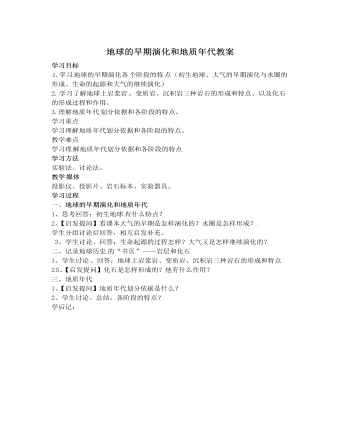
人教版高中地理选修1地球的早期演化和地质年代教案
学习方法实验法、讨论法。教学 媒体投影仪、投影片、岩石标本、实验器具。学习过程一、地球的早期演化和地质年代1、思考回答:初生地球 有什么特点?2、【启发提问】看课本大气的早期是怎样演化的?水圈是怎样形成? 学生分组讨论后回答,相互启发补充。3、学生讨论、回答:生命起源的过程怎样?大气又是怎样继续演化的?二、记录地球历史 的“书页 ”——岩层和化石1、学生讨论 、回答:地球上岩浆岩、变质岩、沉积岩三种岩石的形成和特点2 5、【启发提问】化石是怎样形成的?他有什么作用?三、地质年代1、【启发提问】地质年代划分依据是什么?2、学生讨论、总结。各阶段的特点?学后记:
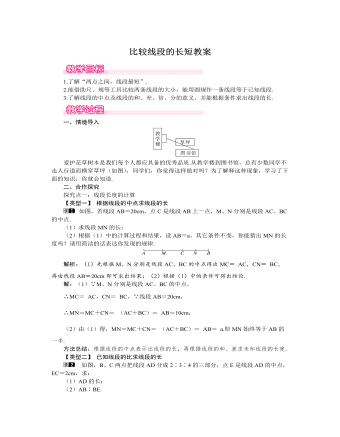
北师大初中七年级数学上册比较线段的长短教案1
1.了解“两点之间,线段最短”.2.能借助尺、规等工具比较两条线段的大小,能用圆规作一条线段等于已知线段.3.了解线段的中点及线段的和、差、倍、分的意义,并能根据条件求出线段的长.一、情境导入爱护花草树木是我们每个人都应具备的优秀品质.从教学楼到图书馆,总有少数同学不走人行道而横穿草坪(如图),同学们,你觉得这样做对吗?为了解释这种现象,学习了下面的知识,你就会知道.二、合作探究探究点一:线段长度的计算【类型一】 根据线段的中点求线段的长如图,若线段AB=20cm,点C是线段AB上一点,M、N分别是线段AC、BC的中点.(1)求线段MN的长;(2)根据(1)中的计算过程和结果,设AB=a,其它条件不变,你能猜出MN的长度吗?请用简洁的话表达你发现的规律.
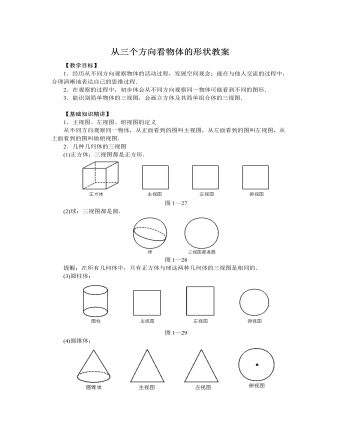
北师大初中七年级数学上册从三个方向看物体的形状教案2
【教学目标】1.经历从不同方向观察物体的活动过程,发展空间观念;能在与他人交流的过程中,合理清晰地表达自己的思维过程.2.在观察的过程中,初步体会从不同方向观察同一物体可能看到不同的图形.3.能识别简单物体的三视图,会画立方体及其简单组合体的三视图.【基础知识精讲】1.主视图、左视图、俯视图的定义从不同方向观察同一物体,从正面看到的图叫主视图,从左面看到的图叫左视图,从上面看到的图叫做俯视图.2.几种几何体的三视图(1)正方体:三视图都是正方形.圆锥的主视图、左视图都是三角形,而俯视图的图中有一个点表示圆锥的顶点,因为从上往下看圆锥时先看到圆锥的顶点,再看到底面的圆.3.如何画三视图 当用若干个小正方体搭成新的几何体,如何画这个新的几何体的三视图?
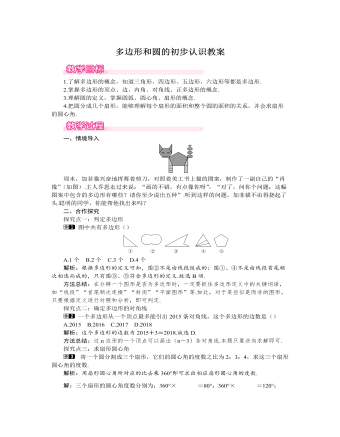
北师大初中七年级数学上册多边形和圆的初步认识教案1
方法总结:在分辨一个图形是否为多边形时,一定要抓住多边形定义中的关键词语,如“线段”“首尾顺次连接”“封闭”“平面图形”等.如此,对于某些似是而非的图形,只要根据定义进行对照和分析,即可判定.探究点二:确定多边形的对角线一个多边形从一个顶点最多能引出2015条对角线,这个多边形的边数是()A.2015 B.2016 C.2017 D.2018解析:这个多边形的边数为2015+3=2018.故选D.方法总结:过n边形的一个顶点可以画出(n-3)条对角线.本题只要逆向求解即可.探究点三:求扇形圆心角将一个圆分割成三个扇形,它们的圆心角的度数之比为2:3:4,求这三个扇形圆心角的度数.解析:用扇形圆心角所对应的比去乘360°即可求出相应扇形圆心角的度数.解:三个扇形的圆心角度数分别为:360°×22+3+4=80°;360°×32+3+4=120°;
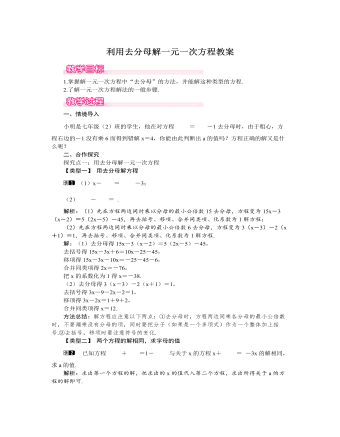
北师大初中七年级数学上册利用去分母解一元一次方程教案1
探究点三:列一元一次方程解应用题某单位计划“五一”期间组织职工到东湖旅游,如果单独租用40座的客车若干辆则刚好坐满;如果租用50座的客车则可以少租一辆,并且有40个剩余座位.(1)该单位参加旅游的职工有多少人?(2)如同时租用这两种客车若干辆,问有无可能使每辆车刚好坐满?如有可能,两种车各租多少辆?(此问可只写结果,不写分析过程)解析:(1)先设该单位参加旅游的职工有x人,利用人数不变,车的辆数相差1,可列出一元一次方程求解;(2)可根据租用两种汽车时,利用假设一种车的数量,进而得出另一种车的数量求出即可.解:(1)设该单位参加旅游的职工有x人,由题意得方程x40-x+4050=1,解得x=360,答:该单位参加旅游的职工有360人;(2)有可能,因为租用4辆40座的客车、4辆50座的客车刚好可以坐360人,正好坐满.方法总结:解题关键是要读懂题目的意思,根据题目给出的条件,找出合适的等量关系,列出方程再求解.
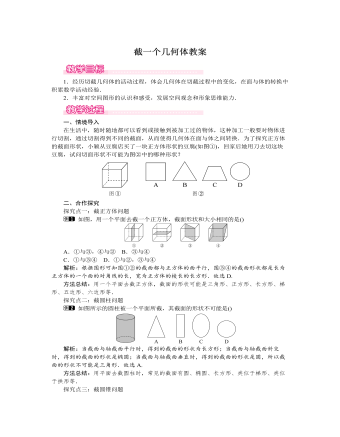
北师大初中七年级数学上册截一个几何体教案1
解析:当截面与轴截面平行时,得到的截面的形状为长方形;当截面与轴截面斜交时,得到的截面的形状是椭圆;当截面与轴截面垂直时,得到的截面的形状是圆,所以截面的形状不可能是三角形.故选A.方法总结:用平面去截圆柱时,常见的截面有圆、椭圆、长方形、类似于梯形、类似于拱形等.探究点三:截圆锥问题一竖直平面经过圆锥的顶点截圆锥,所得到的截面形状与下图中相同的是()解析:经过圆锥顶点的平面与圆锥的侧面和底面截得的都是一条线.如图,由图可知得到的截面是一个等腰三角形.故选B.方法总结:用平面去截圆锥,截面的形状可能是三角形、圆、椭圆等.三、板书设计教学过程中,强调学生自主探索和合作交流,经历操作、抽象、归纳、积累等思维过程,从中获得数学知识与技能,发展空间观念和动手操作能力,同时升华学生的情感态度和价值观.
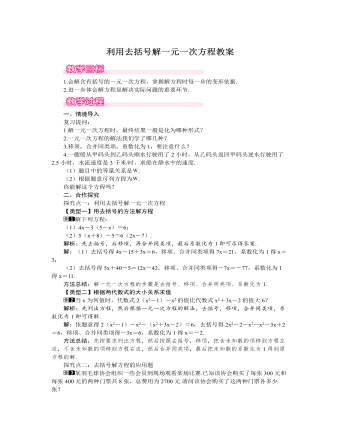
北师大初中七年级数学上册利用去括号解一元一次方程教案1
解:设每张300元的门票买了x张,则每张400元的门票买了(8-x)张,由题意得300x+400×(8-x)=2700,解得x=5,∴买400元每张的门票张数为8-5=3(张).答:每张300元的门票买了5张,每张400元的门票买了3张.方法总结:解题的关键是熟练掌握列方程解应用题的一般步骤:①根据题意找出等量关系;②列出方程;③解方程;④作答.三、板书设计本节课的教学先让学生回顾上一节所学的知识,复习巩固方程的解法,让学生进一步明白解方程的步骤是逐渐发展的,后面的步骤是在前面步骤的基础上发展而成的.然后通过一个实际问题,列出一个有括号的方程,大胆放手让学生去探索、猜想各种解法,去尝试各种解题的途径,启发学生在化归思想影响下想到要去括号.
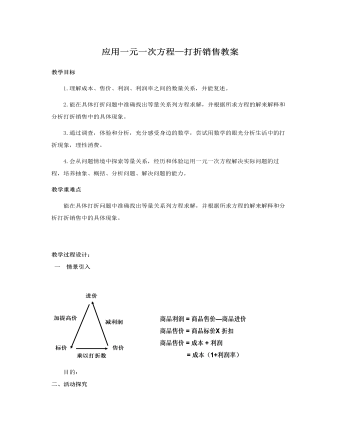
北师大初中七年级数学上册应用一元一次方程——打折销售教案2
两道例题,第一道题师生共同分析,第二道题学生自己分析。部分学生在运用方程解答问题时,等量关系的寻找还是有困难,规范解题不够合理,仍需在作业过程中教师给予适当的指导。四、课堂小结这节课我们学习了有关打折销售的知识,其实类似的问题我们小学也遇到过,今天在分析实际问题时又用到了列表法,通过这节课的学习,谈谈你在知识方面的收获。提示学生通过对《日历中的方程》《我变高了》以及本节《打折销售》学习还有以往经验,让学生分组讨论,用一元一次方程解决实际问题的一般步骤是什么?目的:让学生进一步体会方程的作用,这里教师又提到学生的小学学习,目的是想提示学生,将今天的方程解法与小学学过的算术方法相对比。此活动的目的是使学生不再处于被动状态,而成为积极的发现者。
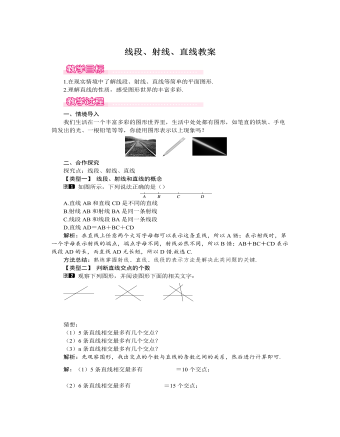
北师大初中七年级数学上册线段、射线、直线教案1
解析:可以根据线段的定义写出所有的线段即可得解;也可以先找出端点的个数,然后利用公式n(n-1)2进行计算.方法一:图中线段有:AB、AC、AD、AE、BC、BD、BE、CD、CE、DE;共4+3+2+1=10条;方法二:共有A、B、C、D、E五个端点,则线段的条数为5×(5-1)2=10条.故选C.方法总结:找线段时要按照一定的顺序做到不重不漏,若利用公式计算时则更加简便准确.【类型四】 线段、射线和直线的应用由郑州到北京的某一次往返列车,运行途中停靠的车站依次是:郑州——开封——商丘——菏泽——聊城——任丘——北京,那么要为这次列车制作的火车票有()A.6种 B.12种C.21种 D.42种解析:从郑州出发要经过6个车站,所以要制作6种车票;从开封出发要经过5个车站,所以要制作5种车票;从商丘出发要经过4个车站,所以要制作4种车票;从菏泽出发要经过3个车站,所以要制作3种车票;从聊城出发要经过2个车站,所以要制作2种车票;从任丘出发要经过1个车站,所以要制作1种车票.再考虑是往返列车,起点与终点不同,则车票不同,乘以2即可.即共需制作的车票数为:2×(6+5+4+3+2+1)=2×21=42种.故选D.
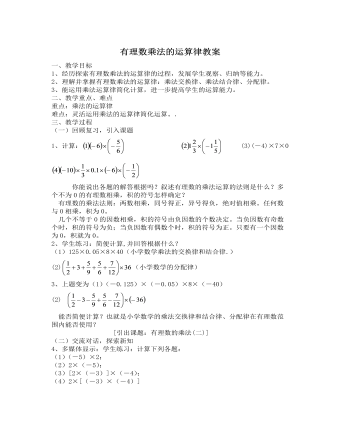
北师大初中七年级数学上册有理数乘法的运算律教案2
分析:(1)(2)用乘法的交换、结合律;(3)(4)用分配律,4.99写成5-0.01学生板书完成,并说明根据什么?略例3、某校体育器材室共有60个篮球。一天课外活动,有3个班级分别计划借篮球总数的 , 和 。请你算一算,这60个篮球够借吗?如果够了,还多几个篮球?如果不够,还缺几个?解:=60-30-20-15 =-5答:不够借,还缺5个篮球。练习巩固:第41页1、2、7、探究活动 (1)如果2个数的积为负数,那么这2个数中有几个负数?如果3个数的积为负数,那么这3个数中有几个负数?4个数呢?5个数呢?6个数呢?有什么规律? (2)逆用分配律 第42页 5、用简便方法计算(三)课堂小结通过本节课的学习,大家学会了什么?本节课我们探讨了有理数乘法的运算律及其应用.乘法的运算律有:乘法交换律:a×b=b×a;乘法结合律:(a×b)×c=a×(b×c);分配律:a×(b+c)=a×b+a×c.在有理数的运算中,灵活运用运算律可以简化运算.(四)作业:课本42页作业题

